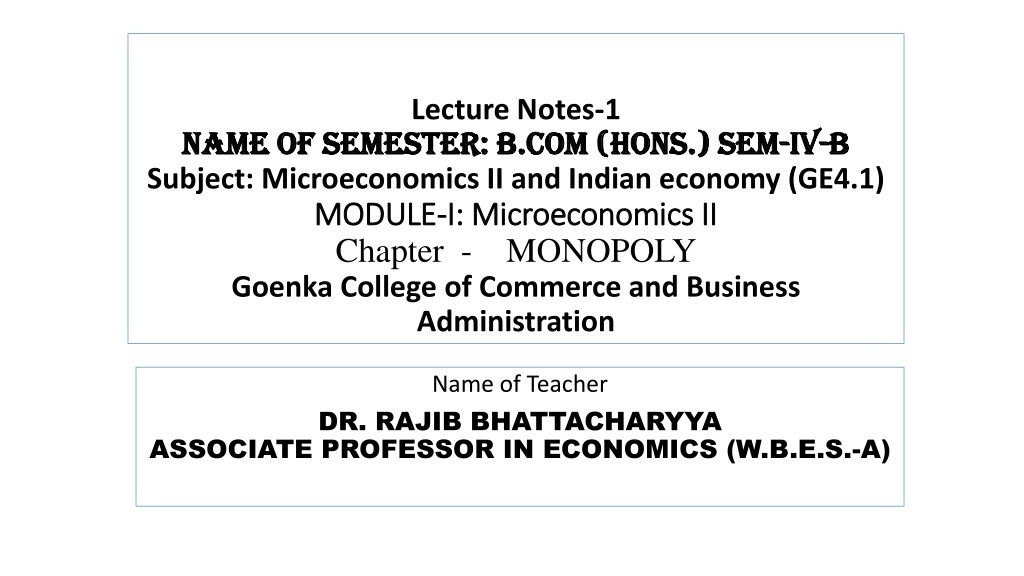Understanding Monopoly in Microeconomics
A comprehensive discussion on the concept of monopoly, its sources of power, short-run and long-run equilibrium of a monopoly firm, price discrimination, and the social cost of monopoly. It also covers practical aspects like measuring monopoly power and the social implications of monopoly behavior such as rent-seeking activities. Key readings and visual aids are provided to enhance comprehension.
Download Presentation

Please find below an Image/Link to download the presentation.
The content on the website is provided AS IS for your information and personal use only. It may not be sold, licensed, or shared on other websites without obtaining consent from the author. Download presentation by click this link. If you encounter any issues during the download, it is possible that the publisher has removed the file from their server.
E N D
Presentation Transcript
Lecture Notes-1 B.Com ( (Hons Name of Semester: Name of Semester: B.Com Subject: Microeconomics II and Indian economy (GE4.1) MODULE MODULE- -I: Microeconomics II I: Microeconomics II Chapter - MONOPOLY Goenka College of Commerce and Business Administration Hons.) SEM .) SEM- -IV IV- -B B Name of Teacher DR. RAJIB BHATTACHARYYA ASSOCIATE PROFESSOR IN ECONOMICS (W.B.E.S.-A)
Topics for Discussion Chapter - MONOPOLY 1. Concept of Monopoly. 2. Sources of monopoly power 3. Short-run and Long-run equilibrium of a monopoly firm 4. Price discrimination 5. Social Cost of Monopoly (concept only). Suggested Readings Pindyck and Rubinfeld, Micro Economics, Pearson Gold & Ferguson, Micro Economic Theory Mankiw.N.G., Principles of Microeconomics, Cengage Samuelson & Nordhaus, Macroeconomics, McGraw Hill
MONOPOLY A monopoly is a market structure which has the following features: a. One seller and many buyers. b. No close substitute good for the product under consideration, exist. c. Entry to the market is barred. Sources of Monopoly: a. Ownership and control over raw material supplies. b. Existence of Patent Laws, Copy-rights, trade-marks (IPR). c. Natural Monopoly (where demand does not permit more than one firm to exist) d. Market Franchise (when the Govt. gives the firm the monopoly right).
Short run equilibrium under monopoly This relationship provides a rule of thumb for pricing. The left-hand side,(P - MC)/P, is the markup over marginal cost as a percentage of price. The relationship says that this markup should equal minus the inverse of the elasticity of demand.
Measuring Monopoly Power This measure of monopoly power, introduced by economist Abba Lerner in 1934, is called the Lerner Index of Monopoly Power. It is the difference between price and marginal cost, divided by price. Mathematically: L = (P - MC)/P The Lerner index always has a value between zero and one. For a perfectly competitive firm, P = MC, so that L = 0. The larger is L, the greater is the degree of monopoly power. This index of monopoly power can also be expressed in terms of the elasticity of demand facing the firm. L = (P - MC)/P = - 1/Ed Ed is now the elasticity of the firm s demand curve ELASTICITY OF DEMAND AND PRICE MARKUP The markup (P MC)/P is equal to minus the inverse of the elasticity of demand facing the firm. If the firm s demand is elastic, as in (a), the markup is small and the firm has little monopoly power. The opposite is true if demand is relatively inelastic, as in (b).
In practice, the social cost of monopoly power is likely to exceed the deadweight loss in triangles B and C of Figure (adjacent) The reason is that the firm may engage in rent seeking: spending large amounts of money in socially unproductive efforts to acquire, maintain, or exercise its monopoly power. Rent seeking might involve lobbying activities (and perhaps campaign contributions) to obtain government regulations that make entry by potential competitors more difficult. Rent seeking activity could also involve advertising and legal efforts to avoid antitrust scrutiny.
Price Discrimination Price discrimination can take three broad forms, which we call first-, second-, and third-degree price discrimination First-Degree Price Discrimination Ideally, a firm would like to charge a different price to each of its customers. If it could, it would charge each customer the maximum price that the customer is willing to pay for each unit bought. We call this maximum price the customer s reservation price. The practice of charging each customer his or her reservation price is called perfect first-degree price discrimination.






























